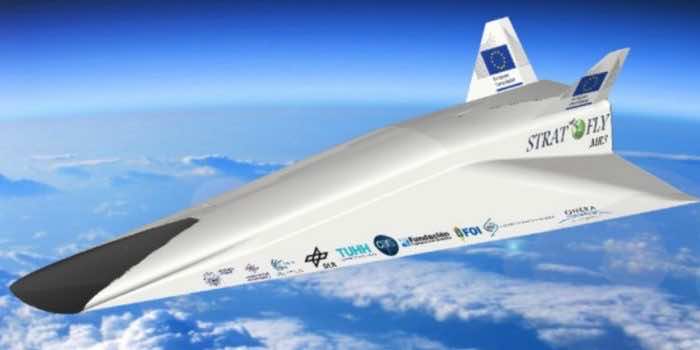The PR team of a Russian entrepreneur, Mikhail Korkorich, describes him as “like Russia’s Elon Musk.” It is said that his new company Destinus has started working on a hydrogen-powered, zero-emissions, transcontinental cargo drone capable of hypersonic Mach 15 cruise speeds.
This Hyperplane, according to Destinus, would “combine the technological advances of a spaceplane with the simple physics of a glider to create a vehicle that meets the demands of a hyper-connected world,” blasting cargo between Europe and Australia in just a couple of hours using clean liquid hydrogen fuel.
The Hyperplane would take off from regular airport runways and fly slowly to the coast before reaching supersonic speeds.
It would then ignite its second stage, a rocket engine, to accelerate to hypersonic speeds between Mach 13 and Mach 15 at mesospheric altitudes over 50 km (160,000 ft) where air resistance is greatly reduced.
“The logic is simple,” said Korkorich. “If you want to move something from one place on Earth to another place on Earth, you need to spend energy in several directions. One, you need to overcome gravity if you’re keeping the plane in the air. So, longer means more gravity losses. The second is against the friction of the air, and the third is for your maximum velocity kinetic energy.”
“Yes, we need to accelerate our vehicle to a very high velocity with the rocket engine. So, we need to spend more energy on acceleration. But because we are flying 10 times faster, and because we are flying at extremely high altitudes … where there’s more than 10 times less air than at 10 km (33,000 ft), our gravity losses and our aerodynamic losses are extremely low. So overall it starts to be very appealing. Actually … we can move stuff from here to another continent cheaper than normal planes. It sounds strange, but it isn’t we just spend less energy on this.”
One of the major steps will be building the rocket that is “almost as re-usable as a jet engine,” and not letting it heat up too much.
Among other things transported, there will be “amazing tuna from the Mediterranean in the kitchen of Japanese restaurants as fresh as if it’s just been caught, eventually at the same price.” By flying way up in the mesosphere, Korkorich says the Hyperplane will generate “10 times less” sonic boom noise.
Destinus has opened four offices, in Spain, France, Switzerland, and Germany. “The capital requirements are immense,” the company says, “Kokorich estimates that he will need more than a billion francs before Destinus is profitable. The first financing round of eleven million this spring was completed in one afternoon, and the investors – most of whom knew Kokorich from his previous companies – only needed a few presentation slides.” The company expects another imminent 25-million round to come in just as easily. “It’s a huge bet Kokorich is making,” continues the blog, “with enormous potential and unclear chances of success.”

The test flight was completed near Munich and it lasted five minutes. It’s focused on “how the hypersonic aero shape would operate at low speeds during the critical phases of take-off and landing.” Thus, the Jungfrau, “about the size of a car,” was kept below 150 km/h (93 mph) and under 20 m (66 ft). “The next one will be ready in early 2022,” says Destinus, “and it will be the size of a bus.”
“I can only say this,” said Matt Thomas of CFD Research Corporation, who has spent more than 30 years researching, developing, and building air turbo rockets, and worked on designs for both AMCOM and CFD. “I obviously don’t follow the literature day today, but many different people have looked at derivatives that could be considered related to the air turbo rocket. The English have done some things, the Russians have done a few things. I’ve never seen it hit pay dirt, where you’re seeing them flying on a day-to-day mission.”
However, there are some limitations related to practicality. In addition, his reputation has been quite controversial which can pose a problem too.
David Szondy stated in 2017: “The kinetic force of a hypersonic projectile can give it the punch of a small tactical nuclear weapon without an ounce of explosives aboard. Small wonder the US Air Force called its ’80s project to drop tungsten arrows from space ‘rods from God.’”
Only time can tell if this will be a successful project.


